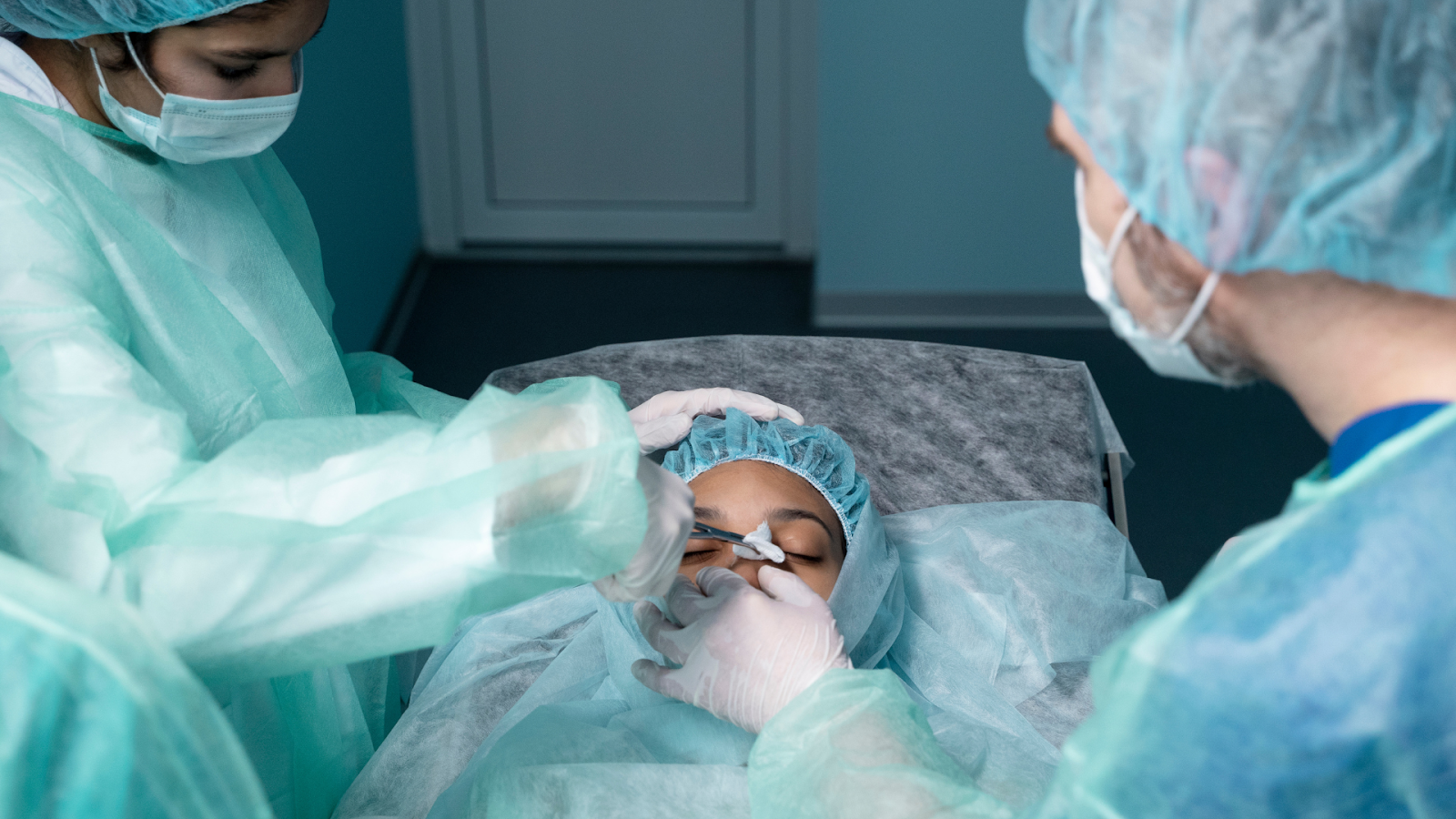When it comes to vision correction, especially for individuals over 40, two commonly discussed procedures are RLE and cataract surgery. Both procedures involve replacing the eye’s natural lens with an artificial one. This can lead to a significant improvement in vision.
The surgical techniques used in both are almost the same. However, the reasons for choosing one over the other, as well as the outcomes, can be quite different.
In this blog, we’ll explain the key similarities and differences between lens replacement and cataract surgery.
What is Refractive Lens Exchange (RLE)?
RLE, also known as Clear Lens Exchange (CLE), is a surgical procedure aimed at correcting refractive errors by replacing the eye’s natural lens with an artificial intraocular lens (IOL).
These artificial lenses come in different types, such as monofocal, multifocal, or toric. IOLs are chosen based on your specific vision needs, including correction for distance, near vision, or astigmatism.
Unlike LASIK or PRK, which reshape the cornea, RLE targets the lens, making it a better solution for individuals with presbyopia or those who are not good candidates for corneal-based surgeries.
Conditions treatable with RLE include:
- Presbyopia: Difficulty seeing close objects due to age-related lens stiffening
- Myopia (Nearsightedness): Trouble seeing distant objects clearly
- Hyperopia (Farsightedness): Blurred vision when viewing nearby objects
- Astigmatism: Distorted or blurred vision caused by irregular corneal shape
Who Is a Good Candidate for RLE?

The best candidates are individuals experiencing age-related vision loss who prefer a long-term correction without relying on glasses or contacts.
Ideal candidates typically:
- Are 40 years of age or older
- Experience presbyopia or other age-related vision changes
- Desire to reduce or eliminate the need for corrective eyewear
- Are ineligible for LASIK due to thin corneas or other contraindications
- Have overall healthy eyes without glaucoma, severe dry eye, or retinal issues
RLE may not be suitable for individuals who:
- Have unstable vision prescriptions
- Suffer from serious eye conditions like macular degeneration or keratoconus
- Are at risk for retinal detachment
What is Cataract Surgery?
Cataract surgery is a medically essential procedure performed to remove a cloudy lens that obstructs vision. Cataracts typically develop slowly over time, and the surgery is performed when vision problems begin to interfere with daily activities.
Like RLE, cataract surgery involves replacing the natural lens with an IOL, but it is done primarily to restore sight, not just improve refractive error. Here are some signs you may need cataract surgery:
- Blurred, cloudy, or foggy vision
- Difficulty seeing at night or in low-light conditions
- Increased glare or halos around lights
- Colors appearing faded or yellowed
- Double vision or ghost images in one eye
- Frequent changes in glasses prescription without significant improvement
Who Is a Good Candidate for Cataract Surgery?
Cataract surgery is typically performed when the patient’s vision loss affects daily life. Since it is considered medically necessary, the procedure is covered by most health insurance plans, including Medicare.
Good candidates for cataract surgery usually:
- Have vision impaired to the point where reading, driving, or daily tasks are difficult
- Cannot achieve clear vision with updated glasses or contacts
- Experience discomfort or safety concerns due to poor vision
- Have been diagnosed with cataracts during an eye examination
- Are generally healthy enough for a quick outpatient surgical procedure

At The Vision Surgeon, we offer advanced cataract surgery using premium lens technology, led by Mr. Hatch Mukherjee. Book your free assessment today and start your journey to clearer vision.
RLE vs. Cataract Surgery: How Are They Similar?
Although RLE and cataract surgery are typically performed for different reasons, the surgical techniques involved in both are virtually identical. In fact, RLE is essentially the same procedure as cataract surgery, just performed earlier in life before a cataract has developed. Both involve replacing the eye’s natural lens with an IOL to improve vision.
Shared characteristics include:
- Lens removal and replacement: Both surgeries involve the removal of the eye’s natural crystalline lens and the implantation of an intraocular lens (IOL) tailored to the patient’s visual needs.
- Outpatient procedures: Both are typically performed in an outpatient setting, allowing patients to return home the same day.
- Quick surgical time: Each eye procedure usually takes about 15 minutes to complete.
- Similar recovery timelines: Most patients experience noticeable vision improvement within a few days, with full recovery occurring within a few weeks.
- Minimal discomfort: Anesthetic eye drops are used during both surgeries, minimizing eye pain and discomfort during the procedure.
- High safety and success rates: Both surgeries are backed by decades of medical advancements, with high patient satisfaction and low complication rates.
- Advanced technology: Both use the same sophisticated equipment and techniques, such as femtosecond lasers and advanced IOLs, ensuring optimal outcomes.
RLE vs. Cataract Surgery: Key Differences
Here’s a breakdown of the core differences between RLE and cataract surgery:
| Feature | Refractive Lens Exchange (RLE) | Cataract Surgery |
| Purpose | Elective surgery to reduce or eliminate the need for glasses/contact lenses | Medically necessary to treat cloudy vision caused by cataracts |
| Patient Age | Typically performed on patients aged 40+ who experience age-related vision loss | Usually done in patients aged 60+ who have developed cataracts |
| Lens Condition | Natural lens is clear but ageing, often with presbyopia or other refractive errors | Natural lens is cloudy, hardened, and yellowed, impairing vision |
| Insurance Coverage | Not covered by insurance, as it is elective and considered cosmetic | Covered by Medicare and most private insurers if medically necessary |
| Lens Options | Offers a full range of premium intraocular lenses (IOLs) such as multifocal, toric, and accommodating lenses—often at an out-of-pocket cost | Basic monofocal lenses are covered; premium options available at extra cost |
| Cataract Prevention | By replacing the natural lens, RLE prevents cataracts from ever forming | Cataract surgery removes an already clouded lens and restores vision |
RLE is often chosen by those proactively seeking better vision without glasses, whereas cataract surgery becomes necessary when cataracts significantly interfere with vision.
Also read: Pterygium Surgery Procedure and Recovery Guide
Lifestyle Impact and Long-Term Results

Both RLE and cataract surgery can dramatically improve visual performance and quality of life. However, the outcomes are tailored to different patient goals: RLE focuses on convenience and independence from glasses, while cataract surgery aims to restore lost vision due to a degenerative condition.
Refractive Lens Exchange:
- Offers patients the potential for freedom from glasses or contact lenses, especially for reading and other daily tasks.
- Greatly improves quality of life for those dealing with presbyopia, farsightedness, or nearsightedness.
- Since the natural lens is replaced with a synthetic one, future cataract development is eliminated.
- Especially appealing for those who lead active lifestyles and want to reduce dependence on corrective eyewear.
Cataract Surgery:
- Helps patients regain clear vision after struggling with cloudy, dim, or distorted sight due to cataracts.
- Improves safety and independence in daily life, especially for driving, reading, and navigating unfamiliar environments.
- Results are long-lasting, though some patients may still require glasses for reading or close-up work, depending on the IOL type chosen.
- For many, it restores confidence and overall well-being after a period of visual decline.
Conclusion
Whether you’re proactively looking to enhance your vision through RLE or seeking to restore clarity through cataract surgery, both procedures offer exceptional results. The most critical step is partnering with a trusted ophthalmologist who can help you understand your options and select the treatment path that’s right for you.
At The Vision Surgeon, led by Mr. Hatch Mukherjee, we offer advanced laser eye surgery, cataract surgery, lens replacement, and pterygium removal with personalised care and cutting-edge technology.
Whether you’re in Essex, Colchester, or nearby, book a consultation today and take the first step toward clearer, brighter vision.
